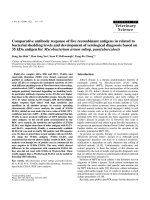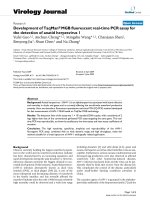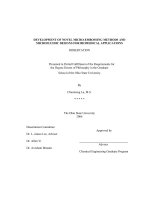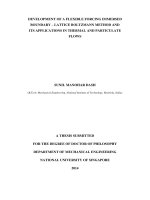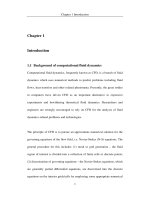Development of immersed boundary phase field lattice boltzmann method for solid multiphase flow interactions
Bạn đang xem bản rút gọn của tài liệu. Xem và tải ngay bản đầy đủ của tài liệu tại đây (5.9 MB, 243 trang )
DEVELOPMENT OF IMMERSED BOUNDARY-PHASE FIELD-
LATTICE BOLTZMANN METHOD FOR SOLID-MULTIPHASE FLOW
INTERACTIONS
SHAO JIANGYAN
A THESIS SUBMITTED
FOR THE DEGREE OF DOCTOR OF PHILOSOPHY
DEPARTMENT OF MECHANICAL ENGINEERING
NATIONAL UNIVERSITY OF SINGAPORE
2013
Declaration
I hereby declare that this thesis is my original work and it has been written by me in its
entirety. I have duly acknowledged all the sources of information which have been used in
the thesis.
This thesis has also not been submitted for any degree in any university previously.
SHAO Jiangyan
2013
i
Acknowledgements
First and foremost, I would like to express my deepest gratitude to my supervisors, Professor
Shu Chang and Professor Chew Yong Tian, for their invaluable guidance, great patience and
continuous support throughout my Ph.D. study.
In addition, I would also like to express my sincere appreciation to the National University of
Singapore for providing me various essential assistances to complete this work, including
research scholarship, abundant library resources and the advanced computing facilities as
well as a good study environment. The assistance and help from NUS staff, my colleagues
and friends are also highly appreciated.
Finally, I would like to thank my family for their endless love, encouragement and
understanding.
SHAO Jiangyan
ii
Table of Contents
Acknowledgements i
Table of Contents ii
Summary ix
List of Tables xii
List of Figures xiv
Nomenclature xx
iii
Chapter 1
Introduction 1
1.1
Background 1
1.2
Modeling of Multiphase Flow 4
1.2.1
Navier-Stokes solvers for multiphase flow simulation 4
1.2.2
Lattice Boltzmann methods for multiphase flow simulation 9
1.2.3
Challenges faced by phase-field LBM 10
1.2.3.1
Accuracy and efficiency balance in phase-field LBM 11
1.2.3.2
LBM for multiphase flow with density contrast 13
1.3
Modeling of Solid-Fluid Interactions 15
1.4
Objectives of the Thesis 18
1.5
Organization of the Thesis 20
Chapter 2
Free Energy-Based Phase-Field Method 24
2.1
Free Energy Theory 24
2.2
Governing Equations in Navier-Stokes Formulation 26
2.3
Governing Equations in Lattice Boltzmann Framework 27
2.4
Wetting Boundary Conditions 30
2.5
Numerical Validations 32
2.5.1
Rotation of a Zalesak’s disk 32
iv
2.5.2
Deformation of a circular interface 33
2.5.3
Droplet deformation in shear flow 34
2.6
Concluding Remarks 35
Chapter 3
Development of a Stencil Adaptive Phase-Field Lattice
Boltzmann Method for Two-Dimensional Incompressible
Multiphase Flows 45
3.1
Stencil Adaptive Algorithm 46
3.2
Stencil Adaptive Phase-Field Lattice Boltzmann Method 50
3.2.1
Implementation of streaming process 50
3.2.2
Approximation of spatial derivatives in interface capturing LBE 53
3.2.3
Refinement of the stencil near boundary 54
3.3
Results and Discussions 55
3.3.1
Stationary bubble 56
3.3.1.1
Effect of interface width 56
3.3.1.2
Effect of stencil refinement on Cahn number, solution accuracy
and computational efficiency 58
3.3.1.3
Validation of Laplace law 60
3.3.2
Bubble rising under buoyancy 60
v
3.3.3
Spreading of a droplet in the partial wetting regime 63
3.4
Concluding Remarks 65
Chapter 4
Development of a Free Energy-Based Phase-Field Lattice
Boltzmann Method for Simulation of Multiphase Flow with
Density Contrast 81
4.1
Review of Z-S-C model and incompressible transformation 82
4.1.1
Z-S-C model 82
4.1.2
Incompressible transformation 85
4.2
New Free Energy-Based Lattice Boltzmann Model for Multiphase Flow
with Density Contrast 87
4.3
Results and Discussions 92
4.3.1
Viscous coupling in a 2D channel 93
4.3.2
Rayleigh-Taylor instability 94
4.3.3
Droplet splash on a wet surface 95
4.3.4
Off-center droplet collision 97
4.3.5
Drop impact on dry walls 98
4.4
Concluding Remarks 101
vi
Chapter 5
Development of an Immersed Boundary Method to Simulate
Solid-Fluid Interactions 116
5.1
Immersed Boundary Method 117
5.2
Immersed Boundary Method for Dirichlet Boundary Condition 119
5.3
Immersed Boundary Method for Neumann Boundary Condition 123
5.3.1
Flux contribution at the control surface to dependent variable in a
control volume 124
5.3.2
Implementation of Neumann boundary condition in the context of
IBM 125
5.3.3
Application to solid-multiphase flow interactions 128
5.4
Some Test Examples 131
5.4.1
Flow over a circular cylinder 131
5.4.2
Fish motion 134
5.4.3
Flow over a sphere 137
5.4.4
Transition layers on hydrophilic and hydrophobic walls 138
5.4.4.1
Effect of transition layer thickness 139
5.4.4.2
Effect of
n
s
141
5.5
Concluding Remarks 142
vii
Chapter 6
Application of Immersed Boundary-Phase Field-Lattice
Boltzmann Method for Solid-Multiphase Flow Interactions 161
6.1
Solid-Multiphase Flow Interactions 162
6.2
Simulation Procedures 164
6.3
Results and Discussions 165
6.3.1
Droplet dewetting 166
6.3.1.1
Grid-independency test 167
6.3.1.2
Influence of surface wettability 168
6.3.2
Droplet spreading on a plate in partial wetting regime 169
6.3.3
Droplet spreading on a curved surface 172
6.3.4
Contact line on a single and two alongside circular cylinders 172
6.3.4.1
Single cylinder 173
6.3.4.2
Two alongside cylinders 174
6.3.5
Impulsive motion of a submerged circular cylinder 175
6.3.6
3D droplet spreading on a smooth surface 176
6.3.7
3D droplet on a curved surface 176
6.4
Concluding Remarks 177
viii
Chapter 7
Conclusions and Recommendations 195
7.1
Conclusions 195
7.2
Recommendations 199
References 201
ix
Summary
Throughout fluid dynamics history, the fundamental importance and wide application bring
the study of solid-fluid interaction a sustained academic and industrial interest. Among solid-
fluid interactions, numerical simulation of solid-multiphase flow interaction might still be one
of the most challenging topics in Computational Fluid Dynamics (CFD). The difficulties arise
from the necessity of treating two distinct types of interfaces, fluid-fluid interface and solid
boundary, simultaneously. To simulate such a problem, a multiphase flow solver and
implementation of boundary conditions on a solid boundary are necessary. This work is
devoted to study numerical methods in these two respects respectively and also establish a
unified framework for simulation of solid-multiphase flow interactions.
In respect of multiphase flow solver, this work develops a stencil adaptive phase-field lattice
Boltzmann method (LBM) for two dimensional incompressible multiphase flows. It utilizes
two types of symmetric stencils which can be combined to form a similar structure to D2Q9
lattice model in LBM. This feature allows the present method to maintain the simplicity of
original LBM. Numerical experiments demonstrate that the developed method enables a high
resolution for interfacial dynamics with greater grid distribution flexibility and considerable
saving in computational effort. Additionally, a free energy-based phase-field LBM is also
developed for simulation of multiphase flow with density contrast. The present method is to
improve the Z-S-C model (Zheng et al. 2006) for correct consideration of density contrast in
the momentum equation. To achieve this aim, we start from a LBE of which the particle
distribution function is used to measure the local density. To ensure simulation stability, a
transformation was introduced to change the particle distribution function for the local
x
density and momentum into that for the mean density and momentum. As a result, the present
model enjoys the good property of using the particle distribution function for mean density
and momentum as in Z-S-C model. On the other hand, it can correctly consider the effect of
density contrast in the momentum equation. Numerical examples demonstrate that the present
model can correctly simulate multiphase flows with density contrast, and has an obvious
improvement over the Z-S-C model in terms of solution accuracy.
The other major concern is implementation of boundary conditions such as Dirichlet and
Neumann boundary conditions. Among methods to achieve this aim, Immersed Boundary
Method (IBM) has gained growing popularity for its efficiency and robustness. Nevertheless,
most previous works are restricted to Dirichlet boundary condition. To overcome this
limitation, we take the first endeavour to develop an IBM for Neumann boundary condition
in this work. The primary concept of the current method is to utilize the physical mechanism
and interpret Neumann boundary condition as contribution of flux from the surface to its
relevant physical parameters in a control volume. The developed IBM for Neumann
boundary conditions can also be consistently applied with IBM for Dirichlet boundary
conditions. In this way, both solid-single phase and multiphase flow interactions can be
successfully simulated through IBM in the present work. This work releases IBM from the
long existing restriction and opens the possibility of IBM simulation for ubiquitous fluid-
solid interactions involving Neumann boundary conditions.
Last but not least, the application of immersed boundary phase-field LBM for simulation of
solid-multiphase flow interactions is also demonstrated. Two types of interfaces, fluid-fluid
interface and solid boundaries are successfully implemented simultaneously through the
xi
developed framework. The equilibrium results and dynamic processes of solid-multiphase
flow interactions are compared with results in the literature. Additionally, its capacity to be
adapted to geometrical and/or chemical patterned surface is also demonstrated.
xii
List of Tables
Table 2.1
Parameters of DnQm lattice models
36
Table 2.2
Area loss for the Zalesak’s disk rotation
36
Table 2.3
Important parameters in droplet deformation
37
Table 3.1
Comparison of Cahn number and the number of nodes used in
stencil adaptive LBM
66
Table 3.2
Comparison of total numbers of nodes and running time
between stencil adaptive LBM and standard LBM
66
Table 3.3
Parameters for the bubble rising under buoyancy
67
Table 3.4
Comparison of terminal velocity for bubble rising under
buoyancy
67
Table 3.5
Terminal bubble rising velocities with different refinement
levels
67
Table 3.6
Numerical equilibrium contact angles with different refinement
levels
68
Table 3.7
Efficiency comparison between standard and stencil adaptive
LBM in droplet spreading
68
Table 5.1
Transition Reynolds numbers for the wake around a circular
cylinder
144
xiii
Table 5.2
Comparison of the drag force coefficient
d
C
and recirculation
length L for steady flow over a circular cylinder at Re = 20 and
40
144
Table 5.3
Comparison of the drag coefficient for flow over a cylinder at
Re = 100
145
Table 5.4
The polynomial coefficients for fish motion
145
Table 5.5
Maximum and minimum drag coefficients for fish motion
145
Table 5.6
Comparison of the drag coefficient for flow over a sphere
146
Table 5.7
Comparison of
on cylinder surface with theoretical
prediction
146
Table 5.8
Maximum error on the boundary
147
Table 5.9
Influence of grid size on
value on the boundary
147
Table 5.10
Comparison of
value on the boundary
148
Table 6.1
Three sets of Lagrangian grid and ratio of Lagrangian grid
spacing over Eulerian grid spacing
178
Table 6.2
Comparison of equilibrium contact angle on flat plate
178
Table 6.3
Comparison of droplet shape on curved surface
178
Table 6.4
Comparison of equilibrium contact angle on circular cylinder
178
xiv
List of Figures
Fig. 2.1
Sketches of some DnQm lattice velocity models
38
Fig. 2.2
The non-dimensional wetting potential versus the equilibrium
contact angle
39
Fig. 2.3
Zalesak’s disk at time 0, 0.25T, 0.5T, 0.75T and T
40
Fig. 2.4
Interface deformation in shear flow
41
Fig. 2.5
Interface deformation in shear flow by VOF method
42
Fig. 2.6
Comparison of deformation parameter at different capillary
numbers
43
Fig. 2.7
Droplet shape with different Capillary numbers
44
Fig. 3.1
Configuration of Orthogonal and Diagonal stencils
69
Fig. 3.2
Stencil at an arbitrary point i changes from level 0 to level 1
69
Fig. 3.3
Assistant nodes for interpolation of a newly inserted node k
70
Fig. 3.4
Sketch of local interpolation for a reference node
i
and
streaming on a diagonal-orthogonal stencil
70
Fig. 3.5
Sketch for the interpolation of
1l
along a horizontal line
71
Fig. 3.6
Sketch of points used for approximation of the first and second
order derivatives
71
xv
Fig. 3.7
Stencil structure on the boundary
72
Fig. 3.8
Surface tension versus interface width
73
Fig. 3.9
Local interface profile with gird distribution and different
resolution levels
74
Fig. 3.10
Interface profile when resolution level increases from 0 to 6
75
Fig. 3.11
Validation of Laplace law
75
Fig. 3.12
Evolution of the bubble velocity at different
Eo
76
Fig. 3.13
Shape of the bubble at different
Eo
with local grid distribution
77
Fig. 3.14
Bubble shape with different levels of refinement
78
Fig. 3.15
The equilibrium contact angle versus dimensionless wetting
coefficient
79
Fig. 3.16
Droplet shapes at different equilibrium contact angles
79
Fig. 3.17
Droplet shapes with grid distribution at different time
80
Fig. 4.1
Sketch of viscous coupling in a 2D channel
102
Fig. 4.2
Profile of
x
u
in the middle of a channel
102
Fig. 4.3
Time evolution of spike and bubble position
103
Fig. 4.4
Interface shape with streamline at Time 1.5
103
Fig. 4.5
Fluid interface evolution of Rayleight Taylor instability
104
xvi
Fig. 4.6
Rayleight Taylor instability at Re = 256
104
Fig. 4.7
Problem setup of droplet splash on wet surface
105
Fig. 4.8
Time evolution of droplet splashing radius
105
Fig. 4.9
Droplet splashing process at Reynolds numbers of 50 and 200
107
Fig. 4.10
Problem setup of two-droplets collision
107
Fig. 4.11
Droplet collision at We = 60, B = 0.27
109
Fig. 4.12
Droplet collision at We = 60, B = 0.91
111
Fig. 4.13
Sketch of drop impact problem
112
Fig. 4.14
Time evolution of spread factor
112
Fig. 4.15
Droplet deformation at different time stages
113
Fig. 4.16
Evolution of spread factor with different Ohnesorge numbers
114
Fig. 4.17
Evolution of spread factor for drop impact on a dry wall
114
Fig. 4.18
Droplet deformation with Bond number 10
115
Fig. 4.19
Droplet deformation with Bond number 50
115
Fig. 5.1
Sketch of a control volume with flux
149
Fig. 5.2
Illustration of flow domain, immersed boundary points and
influence region of boundary points to surrounding fluids
149
Fig. 5.3
Geometry of the flow domain and the circular cylinder
150
xvii
Fig. 5.4
Local mesh around the cylinder
150
Fig. 5.5
Streamlines around the cylinder at Re = 20 simulated by the
conventional IBM and boundary condition-enforced IBM
150
Fig. 5.6
Streamlines around the cylinder at Re = 40 simulated by the
conventional IBM and boundary condition enforced IBM
151
Fig. 5.7
Streamlines around the cylinder
151
Fig. 5.8
Instantaneous positive-negative vorticity around the cylinder
151
Fig. 5.9
Time evolution of the drag and lift coefficients
152
Fig. 5.10
The amplitude of fish undulation approximated by third order
polynomial
152
Fig. 5.11
Local non-uniform mesh around NACA0012-shaped fish
contour
153
Fig. 5.12
Streamlines around the swimming fish
154
Fig. 5.13
Vorticity contour around the swimming fish
155
Fig. 5.14
The drag coefficient of fish swimming for different frequencies
at Re = 7200
156
Fig. 5.15
Sketch of a rectangle flow domain
156
Fig. 5.16
Local mesh around the sphere
157
Fig. 5.17
Streamlines of steady axisymmetric flows at Re = 100
157
xviii
Fig. 5.18
Streamlines of steady axisymmetric flows at Re = 200
158
Fig. 5.19
Streamlines of steady non-axisymmetric flow at Re = 250
158
Fig. 5.20
Streamlines of steady non-axisymmetric flow at Re = 250
159
Fig. 5.21
Initial flow field with solid particle located at the center
159
Fig. 5.22
Transition layer generated along the solid surface due to
implementation of wetting boundary conditions through
immersed boundary method
160
Fig. 5.23
Theoretical and numerical
values on the boundary versus
the non-dimensional wetting potential
160
Fig. 6.1
Evolution of
Drop
Y
179
Fig. 6.2
Evolution of
Drop
Y
179
Fig. 6.3
Evolution of droplet
Drop
V
180
Fig. 6.4
Equilibrium statuses of the spreading droplet on a flat plate
180
Fig. 6.5
Two ways to calculate equilibrium contact angle for droplet
spreading on smooth surface
181
Fig. 6.6
The non-dimensional wetting potential versus the theoretical
and numerical equilibrium contact angle
182
Fig. 6.7
The time evolution of non-dimensional droplet height and
diameter when
60
eq
182
xix
Fig. 6.8
Spreading process of a droplet with three different equilibrium
contact angles
183
Fig. 6.9
Level curves of order parameter together with velocity vector
field during spreading process
184
Fig. 6.10
The results of contact lines on the curved surface with different
equilibrium contact angles
185
Fig. 6.11
Contact line on a single circular cylinder
186
Fig. 6.12
Schematic depiction of contact angle definition on a circular
cylinder
186
Fig. 6.13
Contact line on two alongside cylinders with the same as well
as different surface wettability
187
Fig. 6.14
A sketch of motion of an immersed cylinder
188
Fig. 6.15
Interface disturbance caused by impulsively started motion of
cylinder
189
Fig. 6.16
Interaction of a moving cylinder with the free surface
190
Fig. 6.17
3D droplet spreading on the smooth plate
191
Fig. 6.18
A sketch of concave surface in computational domain
192
Fig. 6.19
Comparison of the droplet wetted distance on surface
192
Fig. 6.20
3D droplet shape on the concave surface
193
Fig. 6.21
3D droplet shape on the convex surface
194
xx
Nomenclature
Roman Letters
d
C
Drag coefficient
l
C
Lift coefficient
Ca
Capillary number
Cn
Cahn number
e
Lattice velocity vector
Eo
Eotvos
number
b
F
Body force
f
Density distribution function
eq
f
Equilibrium density distribution function
1
H
f
Inverse of the Hoffman function
m
h
Characteristic length of a stencil
M
Mobility
Mo
Morton number
xxi
Oh
Ohnesorge number
p
Pressure
q
Flux vector
Re
Reynolds number
t
Time
, , ,U U u u
B
Velocity vector
,uu
B
Velocity correction vector
w
Interface width
w
Lattice model coefficients
We
Weber number
X
B
,
x
Coordinate vector
x, y, z
Coordinate
Greek Letters
Lattice velocity direction
Small expansion parameter
Contact angle
xxii
eq
Equilibrium contact angle
Coefficients in free energy function
Dynamic viscosity
Chemical potential
Density
Surface tension
Relaxation parameter
Kinematic viscosity
Phase concentration
Bulk
Phase concentration in bulk region
s
Phase concentration on solid surface
Bulk fee energy
Collision operator
Wetting potential
Free energy function
xxiii
Abbreviations
CFD
Computational Fluid Dynamics
2D
Two-Dimensional
3D
Three-Dimensional
LBM
Lattice Boltzmann Method
LBE
Lattice Boltzmann Equation
IBM
Immersed Boundary Method
IIM
Immersed Interface Method
N-S
Navier-Stokes
C-H
Cahn-Hilliard
AMR
Adaptive Mesh Refinement
VOF
Volume Of Fluid
LS
Level Set
SLIC
Simple Line Interface Calculation
PLIC
Piecewise Linear Interface Construction
SOLA
Subtractive Optimally Localized Averages

